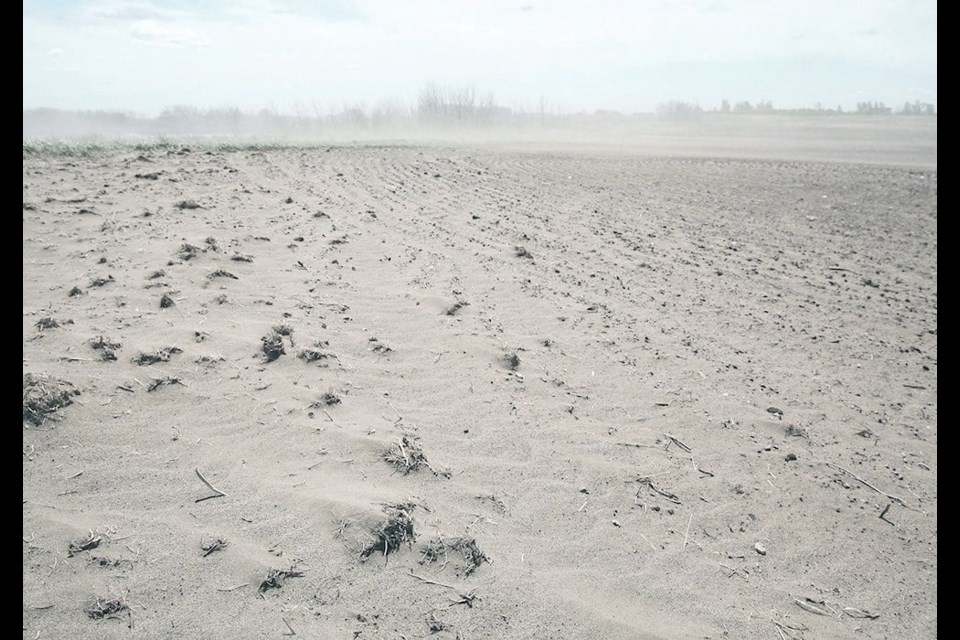WESTERN PRODUCER — Soil moisture conditions in western Saskatchewan are far worse than they were in the Dirty Thirties, says a farm leader.
“It’s not just a little bit drier than the 1930s, it’s way drier,” said Garner Deobald, president of the Saskatchewan Stock Growers Association.
For instance, annual precipitation in Swift Current so far in 2022 is 300 millimetres below average, which is twice as bad as the worst year in the 1930s.
This will be the 11th straight year of below-average precipitation. In the 1930s the longest streak was two consecutive years.
Deobald said today’s farmers have the know-how, the equipment and the crop genetics to get through these tough times. But he thinks people need to understand just how bone dry it has become in that region of the Prairies.
“It should be attention-getting,” he said.
“It’s just desperately dry. No matter what happens here now at this point in time, it’s going to be a really difficult spring.”
Soil moisture conditions are worse than they were a year ago in the rectangle roughly defined by Saskatoon west to the Alberta border and south to the Montana border.
An estimated 78 percent of the province’s cropland is rated short to very short of topsoil moisture, according to the province’s final crop report.
“Even the regions that started the year with a surplus of moisture are now becoming very dry and producers are hoping for rain soon,” stated the report dated Oct. 20.
Conditions are also suboptimal in Alberta, where 40 percent of the cropland had poor surface soil moisture as of Oct. 11, according to that province’s final crop report.
Saskatchewan’s crop report was published before the Oct. 23 snowstorm that delivered 30 centimetres of wet snow to places like Moose Jaw.
“It’s really good that we got this snow, (but) I know a lot of producers would have preferred it to be rain instead,” said Matthew Struthers, crop extension specialist with Saskatchewan Agriculture.
Once it all melts it will probably amount to about 20 millimetres of moisture in some of the more fortunate areas, which is helpful but won’t break the drought conditions heading into winter.
“It’s not going to be the save-all,” he said.
“(But) I’m hoping maybe this snowfall is the beginning of a break in that dry cycle.”
Many growers in western Saskatchewan elected not to plant winter wheat and fall rye because their soils were too dry. Those who did seed winter cereals are reporting that the crop did not germinate well or at all.
The southwest is in a particularly precarious position.
“This region is in desperate need of moisture and without any this fall they will need large early spring rains to ensure their soils can support germination,” stated the crop report.
Farmers planting grain crops have a little more leeway than livestock producers because crops can still germinate and grow if there’s a late spring rain, while hay and pastureland will already be off to a poor start by then.
Winter cereal planting is down 38 percent in the southwest.
The conditions in west-central Saskatchewan are not much better.
“Producers are praying for rain this fall to allow their soil moisture to recharge before winter arrives and the ground freezes,” stated the crop report.
A multi-day soaker is needed to have enough moisture for crop germination and for the regrowth of pasture next spring.
“Without sufficient moisture, many producers fear they will not be able to graze cattle on a large majority of their land,” stated the crop report.
Deobald said some cattle producers have enough feed reserves to get them through the winter but those who have suffered through four to five years of drought will have to buy feed and they can’t afford to do that for long.
“The only option really is to sell cows and downsize,” he said.
Deobald said the SSGA believes an underlying inequity exists in Canada’s business risk management programs.
It is pushing for improvements in programs like crop insurance and AgriStability that would provide more support for livestock producers.




